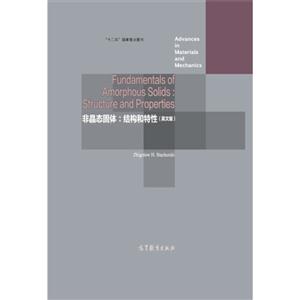非晶态固体:结构和特性-(英文版) 版权信息
- ISBN:9787040426298
- 条形码:9787040426298 ; 978-7-04-042629-8
- 装帧:一般胶版纸
- 册数:暂无
- 重量:暂无
- 所属分类:>>
非晶态固体:结构和特性-(英文版) 本书特色
本书采用独特的方法阐述了非晶态固体的基础理论。将非晶态固体分为无机玻璃、有机玻璃、玻璃金属合金和薄膜四类,构建了非晶态固体的结构模型,定义了理想的非晶体固体的原子排列,澄清了玻璃固体中非晶态原子排列的奥秘。 本书是学习路径积分的一本经典著作,不仅可供物理系师生使用,也是专业人员极好的参考资料。
非晶态固体:结构和特性-(英文版) 内容简介
本书采用独特的方法阐述了非晶态固体的基础理论。将非晶态固体分为无机玻璃、有机玻璃、玻璃金属合金和薄膜四类,构建了非晶态固体的结构模型,定义了理想的非晶体固体的原子排列,澄清了玻璃固体中非晶态原子排列的奥秘。
非晶态固体:结构和特性-(英文版) 目录
Preface1 Spheres, Clusters and Packing of Spheres1.1 Introduction1.2 Geometry of Spheres1.2.1 A Sphere and Its Neighbours1.2.2 Neighbours by Touching1.2.3 Hard and Soft Spheres1.3 Geometry of Clusters1.3.1 Regular Clusters1.3.2 Irregular Clusters1.3.3 Coordination of (1+k) Clusters1.3.3.1 Blocking Model for Cluster Formation1.3.3.2 Furth Model for Cluster Formation1.3.4 Configuration of (1+k) Clusters1.3.4.1 Regular Clusters1.3.4.2 Irregular Clusters1.3.4.3 Closing Vector Based on Radial Vector Polygon1.3.4.4 Physical Meaning of the Closing Vector,1.3.4.5 Spherical Harmonics1.4 Geometry of Sphere Packings1.4.1 Fixed and Loose Packings1.4.2 Ordered Packing1.4.3 Disordered Packing1.4.4 Random Packing1.4.5 Random Sequential Addition of Hard Spheres1.4.6 Random Closed Packing of Spheres1.4.7 Neighbours by Voronoi Tessellation1.4.8 Neighbours by Coordination Shell1.4.8.1 Pair Distribution Function1.4.8.2 The Probability of Contacts1.4.8.3 Contact Configuration Function1.9.4 Short and Medium Range OrderReferencesBooks on CrystallographyBooks on GlassesBooks on Random WalksBooks on Sphere PackingsBooks on Crystal Imperfections2 Characteristics of Sphere Packings2.1 Geometrical Properties2.1.1 The Coordination Distribution Function, ~P(k)2.1.2 Tetrahedricity2.1.3 Voronoi Polyhedra Notation2.1.4 Topology of Clusters2.1.4.1 Ordered Clusters2.1.4.2 Irregular Clusters2.1.5 The Configuration Distribution Function, Φk(ζ)2.1.6 The Volume Fraction2.1.6.1 Regular Polyhedra2.1.6.2 Irregular Polyhedra2.1.7 The Packing Fraction2.1.7.1 The Average Packing Fraction for the Round Cell2.1.7.2 The Local Packing Fraction2.1.7.3 The Limits of Packing Fraction2.1.8 Representative Volume Element2.1.9 Density of Single Phase2.1.9.1 Density of Crystalline Solid2.1.9.2 Density of Amorphous Solid2.1.10 Density of a Composite2.1.11 Solidity of Packing2.2 X-ray Scattering2.2.1 Introduction2.2.2 Geometry of Diffraction and Scattering2.2.3 Intensity of a Scattered Wave2.2.3.1 Amorphous Solid2.2.3.2 Ehrenfest Formula2.2.3.3 Polyatomic Solid2.2.4 Factors Affecting Integrated Scattered Intensity2.2.4.1 Integrated Intensity of Powder Pattern Lines from Crystalline Body2.2.4.2 Integrated Scattered Intensity from Monoatomic Body2.3 Glass Transition Measured by CalorimetryReferences3 Glassy Materials and Ideal Amorphous Solids3.1 Introduction3.1.1 Solidification3.1.1.1 Solidification by Means of Crystallization3.1.1.2 Solidification through Vitrification3.1.2 Cognate Groups of Amorphous Materials (Glasses)3.1.2.1 Metallic Glasses3.1.2.2 Inorganic Glasses3.1.2.3 Organic Glasses3.1.2.4 Amorphous Thin Films3.2 Summary of Models of Amorphous Solids3.2.1 Lattice with Atomic Disorder3.2.2 Disordered Clusters on Lattice3.2.3 Geometric Models for Amorphous Networks3.2.4 Packing of Regular but Incongruent Clusters3.2.5 Irregular Clusters - Random Packing3.2.6 Molecular Dynamics3.2.7 Monte Carlo Method3.3 IAS Model of a-Argon3.3.1 IAS Parameters3.3.2 Round Cell Simulation and Analysis3.3.2.1 Coordination Distribution Function3.3.2.2 Voronoi Volume and Configuration Distribution Functions3.3.2.3 Radial Distribution Function3.3.2.4 X-ray Scattering from the IAS Model3.3.2.5 Crystalline and Amorphous Cluster3.3.3 Summary of a-Ar IAS Structure3.4 IAS Model of a-NiNb Alloy3.4.1 Introduction3.4.2 IAS Model of a-NiNb Alloy3.4.2.1 Coordination Distribution Functions3.4.2.2 Voronoi Volume Distribution3.4.2.3 Pair Distribution Function3.4.2.4 Probability of Contacts3.4.3 X-ray Scattering from a-NiNb Alloy3.4.3.1 Experimental Results3.4.3.2 Theoretical Results3.4.4 Density of a-Ni62-Nb38 Alloy3.4.4.1 Crystalline Alloy3.4.4.2 Amorphous Alloy3.4.5 Summary of a-NiNb IAS Structure3.5 IAS Model of a-MgCuGd Alloy3.5.1 Physical Properties of the Elements3.5.2 IAS Simulation of a-MgCuGd Alloy3.5.2.1 Coordination Distribution Functions3.5.2.2 Configuration Distribution Function3.5.2.3 Radial Distribution Function3.5.2.4 Probability of Contacts3.5.2.5 Cluster Composition According to IAS3.5.2.6 Cluster Composition According to MD3.5.3 X-ray Scattering from a-Mg65-Cu25-Gd10 Alloy3.5.3.1 Fiat Plate X-ray Scattering Pattern3.5.3.2 Calibration based on Si Powder Pattern3.5.3.3 Uncertainties and Corrections3.5.4 Density of Mg65-Cu25-Gd10 Alloy3.5.4.1 Crystalline Alloy3.5.4.2 Amorphous Alloy3.5.5 Summary of a-MgCuGd 1AS Structure3.6 IAS Model of a-ZrTiCuNiBe Alloy3.6.1 Transmission Electron Microscopy3.6.2 IAS Simulation of Amorphous a-ZrTiCuNiBe Alloy3.6.2.1 Coordination Distribution Function3.6.2.2 Voronoi Volume Distribution3.6.2.3 Radial Distribution Function3.6.3 Atomic Probe of the a-ZrTiCuNiBe Alloy3.6.3.1 Probability of Contacts3.6.4 Selected Clusters from the a-ZrTiCuNiBe Alloy3.6.5 X-ray Scattering from the a-ZrTiCuNiBe Alloy3.6.6 Density of ZrTiCuNiBe Alloy3.6.6.1 Crystalline Alloy3.6.6.2 Amorphous Alloy3.6.6.3 Vitreloy Alloys3.6.7 Summary of a-ZrTiCuNiBe IAS Structure3.7 IAS Model of a-Polyethylene (a-PE)3.7.1 Radial Distribution Function3.7.2 X-ray Scattering3.7.2.1 Short-Range Order3.7.3 Summary of a-PE IAS Structure3.8 IAS Model of a-Silica (a-SiO2)3.8.1 Molecular Parameters for SiO23.8.2 IAS and United Atom Models for SiO23.8.3 Summary of a-SiO2 IAS Structure3.9 Chalcogenide Glasses3.9.1 As12-Ge33-Se55 Chalcogenide Glass3.9.2 Measured Coordination Distribution3.9.3 Measured X-ray Scattering3.9.4 Glass-Transition Temperature of AsGeSe Glasses3.9.5 Models of Atomic Arrangements in AsGeSe Glass3.9.5.1 IAS Model of AsGeSe Glass3.9.5.2 Other Models of AsGeSe Glass3.9.6 Summary of a-AsGeSe IAS Structure3.10 Concluding Remarks3.10.1 Chapter 33.10.2 Chapter 2References4 Mechanical Behaviour4.1 Introduction4.2 Elasticity4.2.1 Phenomenology4.2.2 Continuum Mechanics4.2.2.1 Calculation of Average Elastic Constants - Aggregate Theory4.2.2.2 Green's Elastic Strain Energy4.2.3 Atomistic Elasticity4.2.3.1 Calculation of an Elastic Constant for Single Crystal of Argon4.3 Elastic Properties of Amorphous Solids4.3.1 Elastic Modulus of Amorphous Argon4.4 Fracture4.4.1 Phenomenology4.4.2 Continuum Mechanics4.4.2.1 Definition of Fracture Mechanics: Fracture Toughness4.4.2.2 Elastic Strain Energy Release4.4.2.3 Solid Surface Energy4.4.2.4 Griffith's Fracture Stress4.4.2.5 The Role of Defects4.4.3 Atomistic Fracture Mechanics of Solids4.4.3.1 Theoretical Cleavage Strength4.4.3.2 Theoretical Shear Strength4.5 Plasticity4.5.1 Phenomenology4.5.2 Continumm Mechanics4.5.2.1 Tresca Yield Criterion4.5.2.2 Huber-von Mises Criterion4.5.3 Atomistic Mechanics of Crystalline Solids4.5.3.1 Strain Hardening4.5.3.2 Grain Boundary Strengthening4.5.3.3 Solid Solution Hardening4.5.3.4 Precipitation Hardening4.5.3.5 Mechanisms of Plastic Flow in Crystalline Materials4.5.3.6 Displacement of Atoms Around Dislocations4.5.3.7 Critical Shear Stress to Move Dislocation4.6 Plasticity in Plasticity: Amorphous Solids4.6.1 Plastic Deformation by Shear Band Propagation4.7 Superplasticity4.7.1 Phenomenology4.7.2 Continuum Mechanics4.7.3 Superplasticity in Bulk Metallic Glasses4.7.3.1 Calculation of Strain Rate for Superplasticity4.7.4 Concordant Deformation Mechanism4.7.4.1 Density Variation in Amorphous Solids4.7.4.2 The 'Inclusion' Problem4.7.4.3 The System without Transformation4.7.4.4 The System with Transformation4.7.4.5 Conclusions4.8 Viscoelasticity4.8.1 Phenomenology4.8.2 Time-and Temperature-Dependent Behaviour4.8.2.1 Definitions of Viscosity4.8.2.2 Order of Magnitude Calculations4.8.3 Temperature Effect on Viscoelastic Behaviour4.8.3.1 Arrhenius Behaviour4.8.3.2 Vogel-Fulcher-Tammann BehaviourReferencesIndexColor Plots
展开全部
非晶态固体:结构和特性-(英文版) 作者简介
Zbigniew H. Stachurski,澳大利亚国立大学教授。1965年本科毕业于波兰 AGH 科技大学( Krakow),1968年博士毕业于英国Bristol大学。1991年当选澳大利亚皇家化学学会会员,1993年获皇家化学学会“聚合物材料突出贡献奖”。2002年任澳大利亚国立大学材料中心主任。为英国、瑞士、希腊、新加坡等多所高校的访问教授。会讲5种语言:English, Polish, Ukrainian, French, Russian.
书友推荐
本类畅销
-
结构风荷载理论与Matlab计算
¥28.6¥55 -
4.23文创礼盒A款--“作家言我精神状态”
¥42.3¥206 -
4.23文创礼盒B款--“作家言我精神状态”
¥42.3¥206 -
一句顶一万句 (印签版)
¥40.4¥68 -
百年书评史散论
¥14.9¥38 -
1980年代:小说六记
¥52.8¥69





















